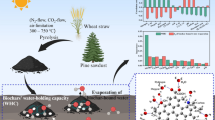Abstract
Acid rain is still an issue of environmental concerns. This study investigated the impacts of simulated acid rain (SAR) upon earthworm activity from the Latosol (acidic red soil). Laboratory experiment was performed by leaching the soil columns grown with earthworms (Eisenia fetida) at the SAR pH levels ranged from 2.0 to 6.5 over a 34-day period. Results showed that earthworms tended to escape from the soil and eventually died for the SAR at pH = 2.0 as a result of acid toxicity. The catalase activity in the earthworms decreased with the SAR pH levels, whereas the superoxide dismutases activity in the earthworms showed a fluctuate pattern: decreasing from pH 6.5 to 5.0 and increasing from pH 5.0 to 4.0. Results implied that the growth of earthworms was retarded at the SAR pH ≤ 3.0.




Similar content being viewed by others
References
Betteridge DJ (2000) What is oxidative stress? Metabolism 49:3–8
Bian Y, Yu S (1992) Forest decline in Nanshan, China. Forest Ecol Manag 51:53–59
Bradford MM (1976) A rapid and sensitive method for the quantitation of microgram quantities of protein utilizing the principle of protein dye-binding. Anal Biochem 72:248–254
Brady N (1984) The natural and properties of soils, 9th edn. Macmillian, London
Brewer GJ (1967) Achromatic regions of tetrazolium stained starch gels: inherited electrophoretic variation. Am J Hum Genet 19:674–680
Chelikani P, Fita I, Loewen PC (2004) Diversity of structures and properties among catalases. Cell Mol Life Sci 61:192–208
Das K, Samanta L, Chainy GBN (2000) A modified spectrophotometric assay of superoxide dismutase using nitrite formation by superoxide radicals. Indian J Biochem Biophys 37:201–204
Galloway JN (1995) Acid deposition: perspectives in time and space. Water Air Soil Pollut 85:15–24
Hauxwell J, Krapfl H, Lamb J, Maurer B (1992) Earthworm preference: analyzing the effects of soil moisture, pH, and calcium levels on the distribution of Lumbricus rubellus. http://www.hdl.handle.net/2027.42/54362
Kochian LV (1995) Cellular mechanisms of aluminum toxicity and resistance in plants. Annu Rev Plant Mol Biol 46:237–260
Larssen T, Carmichael GR (2000) Acid rain and acidication in China: the importance of base cation deposition. Environ Pollut 110: 89–102.
Lei BP, Zhou BT, Cai HW et al (1993) Colorimetry method of catalase activity analysis. Chin J Clin Lab Sci 11:73–74 (in Chinese)
Li DY, Cheng RF (2006) Indicative function of earthworm for eco-environmental quality. J Anhui Agric Sci 34:4637–4638 (in Chinese)
Ling DJ, Zhang JE, Ouyang Y (2007) Advancements in research on impact of acid rain on soil ecosystem: a review. Soils 39:514–521 (in Chinese)
Liu KH, Mansell RS, Rhue RD (1990) Cation removal during application of acid solution into air dry soil columns. Soil Sci Soc Am S4:1747–1753
Menz FC, Seip HM (2004) Acid rain in Europe and the United States: an update. Environ Sci Policy 7:253–265
Nahmani J, Rossi JP (2003) Soil macroinvertebrates as indicators of pollution by heavy metals. CR Biol 326:295–303
Sparks D (1996) Methods of soil analysis. Part 3, Chemical methods. Soil Sci Soc Am American Society of Agronomy, Pages: xxi
Tao F, Feng Z (2000) Terrestrial ecosystem sensitivity to acid deposition in South China. Water Air Soil Pollut 118:231–243
Vitoria AP, Lea PJ, Azevedo RA (2001) Antioxidant enzymes responses to cadmium in radish tissues. Phytochimistry 57:701–710
Wang ZC, Ding LY, Liu W et al (2011) Current status and causes of acid rain in Guangzhou. J Trop Meteorol 27:717–722 (in Chinese)
Zhang JE, Ouyang Y, Ling DJ (2007) Impacts of simulative acid rain on cation leaching from the latosol in South China. Chemosphere 67:2131–2137
Zhang JE, Yu JY, Ouyang Y, Xu HQ (2012) Responses of earthworm to aluminum toxicity in latosol. Environ Sci Pollut Res. doi:10.1007/s11356-012-0969-y
Zhang JE, Yu JY, Ouyang Y, Xu HQ (2013) Impact of simulated acid rain on trace metals and aluminum leaching in Latosol from Guangdong Province, China. Int J Soil Sediment Contam 23:725–735
Acknowledgments
The study was supported by National Natural Science Foundation of China (No. 40871118), Natural Science Foundation of Guangdong Province, China (No. 8151064201000048; No. 9451064201003801; and No. S2011010001570), and China Postdoctoral Special Fund (No. 201003355).
Author information
Authors and Affiliations
Corresponding author
Rights and permissions
About this article
Cite this article
Zhang, JE., Yu, J. & Ouyang, Y. Activity of Earthworm in Latosol Under Simulated Acid Rain Stress. Bull Environ Contam Toxicol 94, 108–111 (2015). https://doi.org/10.1007/s00128-014-1404-5
Received:
Accepted:
Published:
Issue Date:
DOI: https://doi.org/10.1007/s00128-014-1404-5




